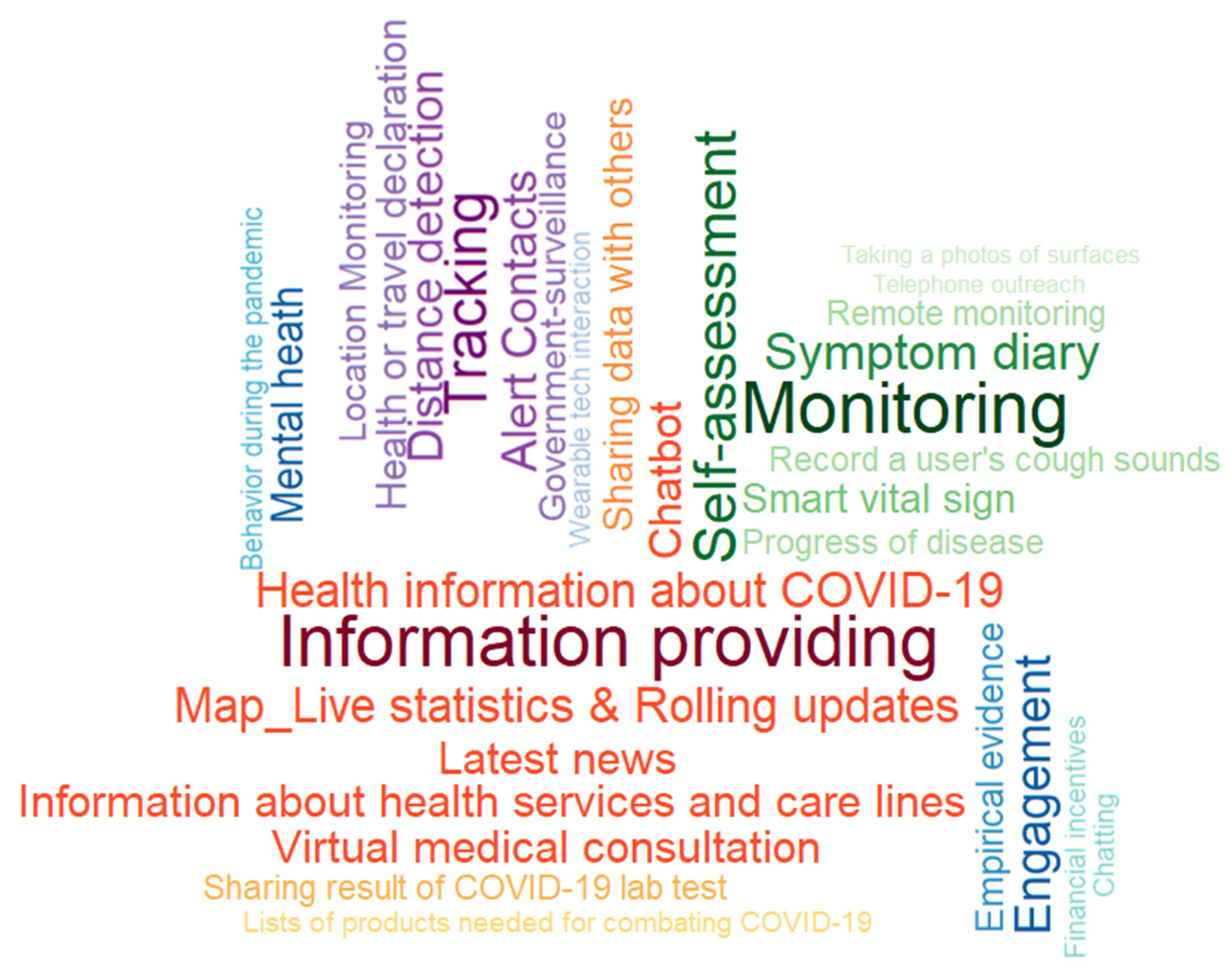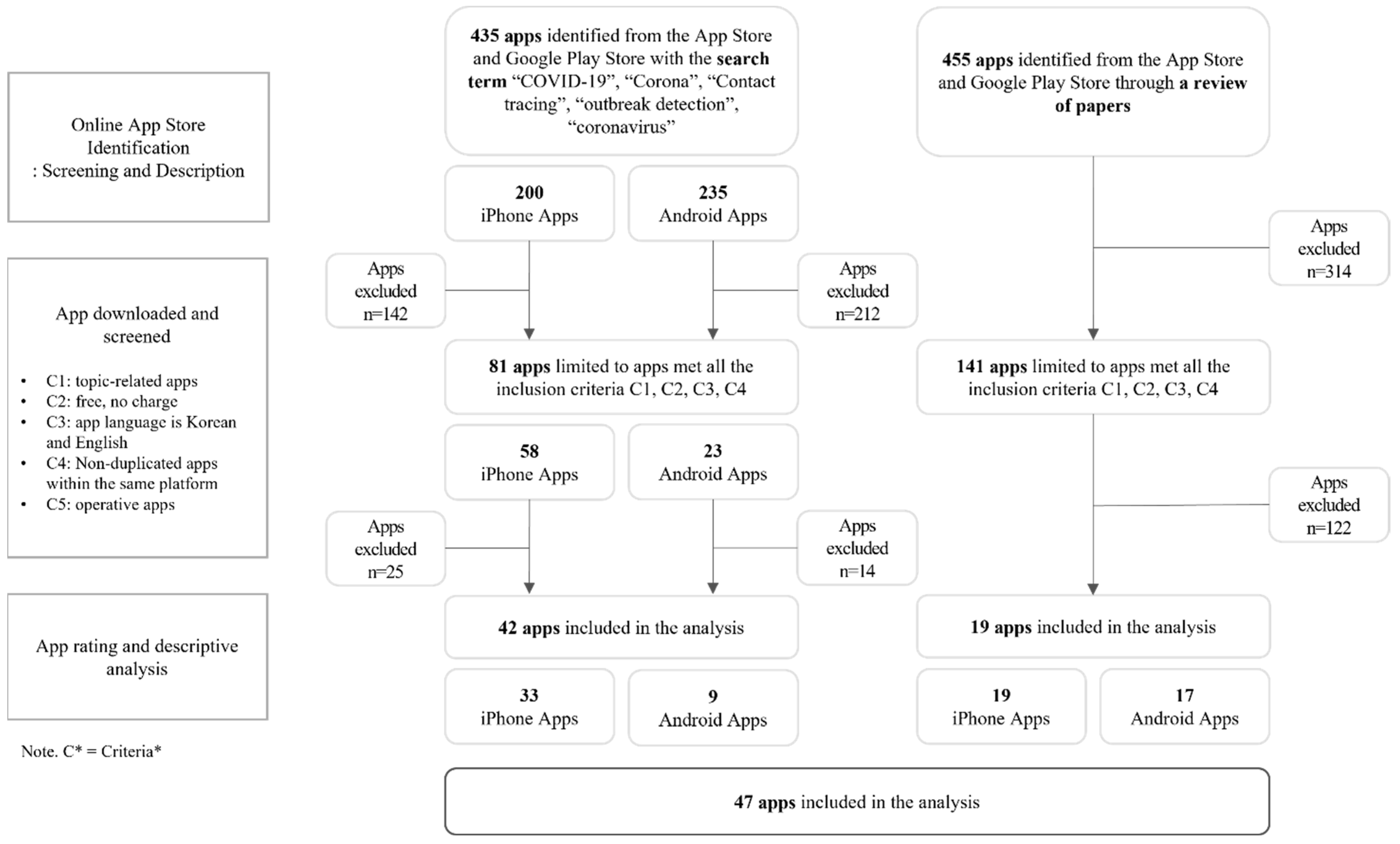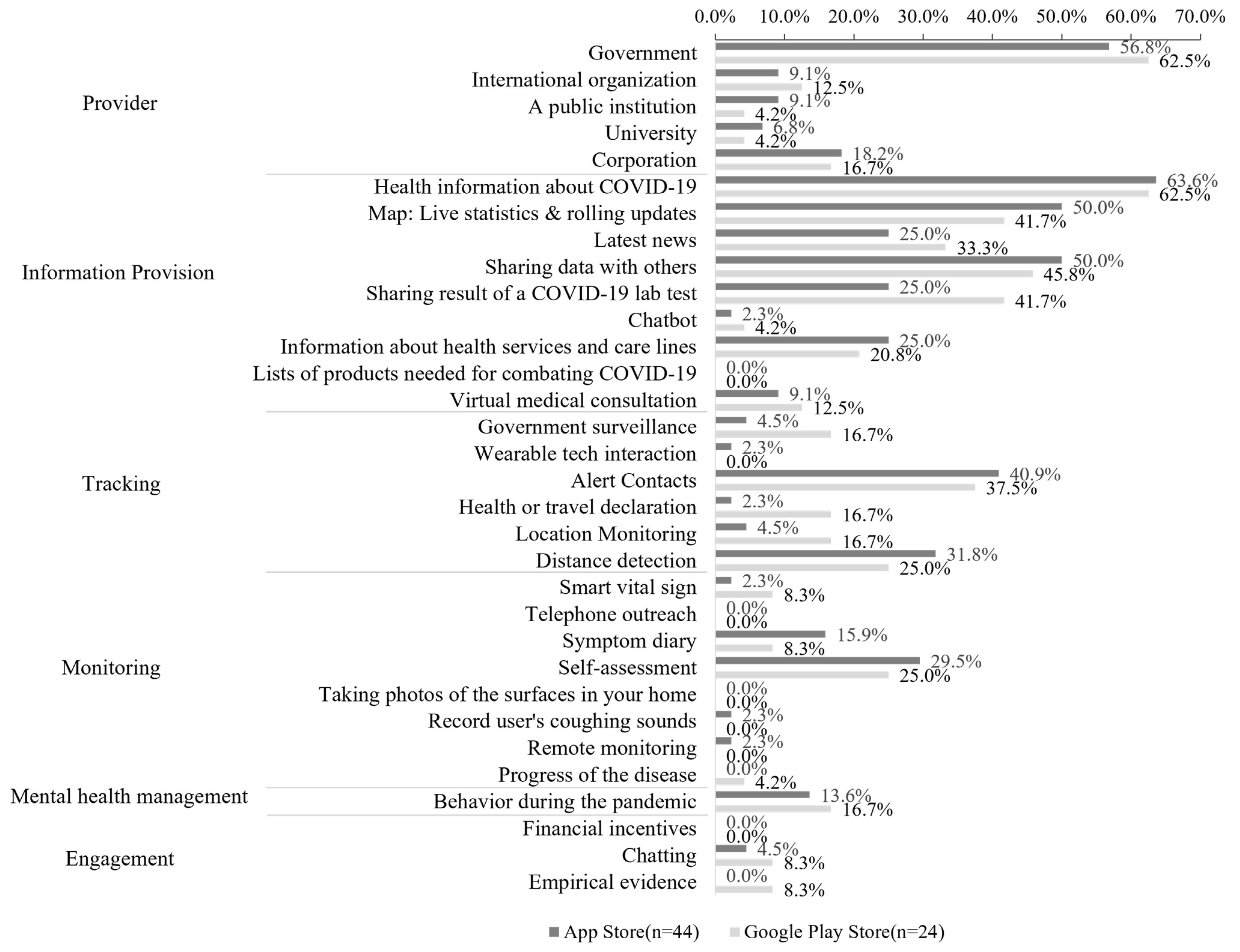Insights from Review and Content Analysis of Current COVID-19 Mobile Apps and Recommendations for Future Pandemics
Abstract
1. Introduction
2. Methods
2.1. Selection of COVID-19 Apps for Content Analysis
2.1.1. Literature Review of COVID-19 Mobile Apps
2.1.2. Selection of COVID-19 Apps
2.2. Content Analysis of COVID-19 Apps
3. Results
3.1. Selection of COVID-19 Apps for Content Analysis
3.2. Content Analysis of COVID-19 Apps
4. Discussion
4.1. Principal Findings
4.2. Recommendations for COVID-19 Apps
4.3. Limitations
5. Conclusions
Supplementary Materials
Author Contributions
Funding
Institutional Review Board Statement
Informed Consent Statement
Data Availability Statement
Acknowledgments
Conflicts of Interest
Appendix A
| Information Provision | Tracking | Monitoring | Mental Health Management | Engagement | |
|---|---|---|---|---|---|
| Manal Almalki, 2021 [7] a | ✔ | ✔ | ✔ | ✔ | |
| Hanson John Leon Singh, 2020 [12] b | ✔ | ✔ | ✔ | ||
| Haridimos Kondylakis, 2020 [15] c | ✔ | ✔ | ✔ | ✔ | |
| Esli Osmanlliu, 2021 [16] d | ✔ | ✔ | |||
| Nouf Sahal Alharbi, 2022 [17] e | ✔ | ✔ | ✔ | ✔ | ✔ |

References
- Collado-Borrell, R.; Escudero-Vilaplana, V.; Villanueva-Bueno, C.; Herranz-Alonso, A.; Sanjurjo-Saez, M. Features and Functionalities of Smartphone Apps Related to COVID-19: Systematic Search in App Stores and Content Analysis. J. Med. Internet Res. 2020, 22, e20334. [Google Scholar] [CrossRef] [PubMed]
- Wirth, F.N.; Johns, M.; Meurers, T.; Prasser, F. Citizen-Centered Mobile Health Apps Collecting Individual-Level Spatial Data for Infectious Disease Management: Scoping Review. JMIR Mhealth Uhealth 2020, 8, e22594. [Google Scholar] [CrossRef] [PubMed]
- Ukpong, I.; Etim, S.; Ana, P. Application of Mobile Technology in Community Transmission Surveillance for 2020 Corona Virus Disease; Nigerian Academy of Science: Akoka-Yaba, Nigeria, 2020. [Google Scholar]
- Alwashmi, M.F. The Use of Digital Health in the Detection and Management of COVID-19. Int. J. Environ. Res. Public Health 2020, 17, 2906. [Google Scholar] [CrossRef] [PubMed]
- Recommendations on Digital Interventions for Health System Strengthening. Available online: https://www.who.int/publications/i/item/9789241550505 (accessed on 12 October 2022).
- Aslani, N.; Lazem, M.; Mahdavi, S.; Garavand, A. A Review of Mobile Health Applications in Epidemic and Pandemic Outbreaks: Lessons Learned for COVID-19. Arch. Clin. Infect. Dis. 2020, 15, e103649. [Google Scholar] [CrossRef]
- Almalki, M.; Giannicchi, A. Health Apps for Combating COVID-19: Descriptive Review and Taxonomy. JMIR Mhealth Uhealth 2021, 9, e24322. [Google Scholar] [CrossRef]
- Ming, L.C.; Untong, N.; Aliudin, N.A.; Osili, N.; Kifli, N.; Tan, C.S.; Goh, K.W.; Ng, P.W.; Al-Worafi, Y.M.; Lee, K.S.; et al. Mobile Health Apps on COVID-19 Launched in the Early Days of the Pandemic: Content Analysis and Review. JMIR Mhealth Uhealth 2020, 8, e19796. [Google Scholar] [CrossRef]
- About COOV. Available online: https://ncv.kdca.go.kr/menu.es?mid=a12501000000 (accessed on 15 November 2021).
- Lee, B.; Ibrahim, S.A.; Zhang, T. Mobile Apps Leveraged in the COVID-19 Pandemic in East and South-East Asia: Review and Content Analysis. JMIR Mhealth Uhealth 2021, 9, e32093. [Google Scholar] [CrossRef]
- Elkhodr, M.; Mubin, O.; Iftikhar, Z.; Masood, M.; Alsinglawi, B.; Shahid, S.; Alnajjar, F. Technology, Privacy, and User Opinions of COVID-19 Mobile Apps for Contact Tracing: Systematic Search and Content Analysis. J. Med. Internet Res. 2021, 23, e23467. [Google Scholar] [CrossRef]
- John Leon Singh, H.; Couch, D.; Yap, K. Mobile Health Apps that Help with COVID-19 Management: Scoping Review. JMIR Nurs. 2020, 3, e20596. [Google Scholar] [CrossRef]
- Davalbhakta, S.; Advani, S.; Kumar, S.; Agarwal, V.; Bhoyar, S.; Fedirko, E.; Misra, D.P.; Goel, A.; Gupta, L.; Agarwal, V. A Systematic Review of Smartphone Applications Available for Corona Virus Disease 2019 (COVID19) and the Assessment of their Quality Using the Mobile Application Rating Scale (MARS). J. Med. Syst. 2020, 44, 164. [Google Scholar] [CrossRef]
- Mohanty, B.; Chughtai, A.; Rabhi, F. Use of Mobile Apps for epidemic surveillance and response—Availability and gaps. Glob. Biosecurity 2019, 1, 37. [Google Scholar] [CrossRef]
- Kondylakis, H.; Katehakis, D.G.; Kouroubali, A.; Logothetidis, F.; Triantafyllidis, A.; Kalamaras, I.; Votis, K.; Tzovaras, D. COVID-19 Mobile Apps: A Systematic Review of the Literature. J. Med. Internet Res. 2020, 22, e23170. [Google Scholar] [CrossRef] [PubMed]
- Osmanlliu, E.; Rafie, E.; Bédard, S.; Paquette, J.; Gore, G.; Pomey, M.-P. Considerations for the Design and Implementation of COVID-19 Contact Tracing Apps: Scoping Review. JMIR mHealth uHealth 2021, 9, e27102. [Google Scholar] [CrossRef]
- Alharbi, N.S.; Alsubki, N.; Altamimi, S.R.; Alonazi, W.; Fahlevi, M. COVID-19 Mobile Apps in Saudi Arabia: Systematic Identification, Evaluation, and Features Assessment. Front. Public Health 2022, 10, 803677. [Google Scholar] [CrossRef] [PubMed]
- Lee, J.B.; Woo, H. Quality evaluation of smartphone applications for physical activity promotion. Korean J. Health Educ. Promot. 2019, 36, 67–76. [Google Scholar] [CrossRef]
- Lee, J.B.; Kim, J.H.; Bok, J.H.; Woo, H. Quality Analysis of Smart Application Contents for the Convenience of Care and Hospital Access. Korea J. Hosp. Manag. 2020, 25, 1–12. [Google Scholar]
- Paek, H.J. Strategic risk communication for infectious disease outbreaks: The evolving landscape of publics and media. J. Korean Med. Assoc. 2017, 60, 306–313. [Google Scholar] [CrossRef]
- Jaworski, B.K.; Taylor, K.; Ramsey, K.M.; Heinz, A.; Steinmetz, S.; Pagano, I.; Moraja, G.; Owen, J.E. Exploring Usage of COVID Coach, a Public Mental Health App Designed for the COVID-19 Pandemic: Evaluation of Analytics Data. J. Med. Internet Res. 2021, 23, e26559. [Google Scholar] [CrossRef]
- Meacham, M.C.; Vogel, E.A.; Thrul, J. Vaping-Related Mobile Apps Available in the Google Play Store After the Apple Ban: Content Review. J. Med. Internet Res. 2020, 22, e20009. [Google Scholar] [CrossRef]
- Comino, S.; Manenti, F.M.; Mariuzzo, F. Updates management in mobile applications: iTunes versus Google Play. J. Econ. Manag. Strategy 2019, 28, 392–419. [Google Scholar] [CrossRef]
- Wyatt, J.C. How can clinicians, specialty societies and others evaluate and improve the quality of apps for patient use? BMC Med. 2018, 16, 225. [Google Scholar] [CrossRef] [PubMed]
- Cai, X.; Zhang, F.; Lin, C.; Zhang, X.; Wang, Z.; Xing, H.; Nie, L.; Han, X.; Ji, L. Achieving Effective and Efficient Basal Insulin Optimal Management by Using Mobile Health Application (APP) for Type 2 Diabetes Patients in China. Diabetes Metab. Syndr. Obes. Targets Ther. 2020, 13, 1327. [Google Scholar] [CrossRef] [PubMed]
- Salehinejad, S.; Niakan Kalhori, S.R.; Hajesmaeel Gohari, S.; Bahaadinbeigy, K.; Fatehi, F. A review and content analysis of national apps for COVID-19 management using Mobile Application Rating Scale (MARS). Inform. Health Soc. Care 2021, 46, 42–55. [Google Scholar] [CrossRef] [PubMed]
- Agarwal, P.; Gordon, D.; Griffith, J.; Kithulegoda, N.; Witteman, H.O.; Sacha Bhatia, R.; Kushniruk, A.W.; Borycki, E.M.; Lamothe, L.; Springall, E.; et al. Assessing the quality of mobile applications in chronic disease management: A scoping review. NPJ Digit. Med. 2021, 4, 46. [Google Scholar] [CrossRef] [PubMed]
- Solve the Outbreak App. Available online: https://www.cdc.gov/mobile/applications/sto/index.html (accessed on 15 November 2021).
- Robinson, L.A.; Turner, I.J.; Sweet, M.J. The use of gamification in the teaching of disease epidemics and pandemics. FEMS Microbiol. Lett. 2018, 365, fny111. [Google Scholar] [CrossRef]



| Purpose | Content | Description |
|---|---|---|
| Information provision | Health information about COVID-19 | Provide health guideline information related to COVID-19 |
| Map: Live statistics and rolling updates | Statistics by region that can be checked with map information (GIS etc.,) and real-time number of confirmed cases | |
| Latest news | The latest news about COVID-19 and health | |
| Sharing data with others | Capability of building a health diary describing the users’ symptoms and allowing consumers to share their COVID-19 stories with other users | |
| Sharing result of a COVID-19 lab test | Share the results of COVID-19-related research | |
| Chatbot | Chatbots are artificial intelligence (AI)-enabled agents that connect with patients through texting or a human-like voice | |
| Information about health services and care lines | Helplines connect users to consultants who provide useful information related to COVID-19 and facilitate the introduction of patients to healthcare workers on a toll-free number | |
| Lists of products needed for combating COVID-19 | Lists of products required for combating COVID-19 (e.g., gowns, surgical masks, respirators, face shields, and hand sanitizer) | |
| Virtual medical consultation | Virtual medical consultation, live video consultations, or bidirectional text-audio communications to provide personalized support between users and their doctors | |
| Tracking | Government surveillance | e.g., tracking through automated teller machine transactions and surveillance data |
| Wearable tech interaction | Communication of daily mood and health status through AI voice on a wearable device such as a smartwatch | |
| Alert Contacts | Notification when contacting infected people based on technology, such as Bluetooth and GPS | |
| Health or travel declaration | 1. Report yourself and your family and record your daily health status for 14 days after arriving at your travel destination. 2. Some of this content notified users of potential exposure risks in the area where they lived | |
| Location Monitoring | The user selects a specific area from the local options and checks the infectious disease situation in that area in real-time | |
| Distance detection | Improves the user’s ability to avoid close contact with other people around them | |
| Monitoring | Smart vital sign | Check your heart rate, breathing, etc. |
| Telephone outreach | Remote monitoring of self-isolated patients using telephone outreach | |
| Symptom diary | Records and checks your symptoms daily | |
| Self-assessment | Evaluates your physical condition using a self-questionnaire | |
| Taking photos of the surfaces in your home | Inspecting the surface by photography to track hygiene practices | |
| Record user’s coughing sounds | Recording the coughing sounds of the user | |
| Remote monitoring | Health care professionals monitor the patients’ health data such as heart rate and blood oxygen level in real-time | |
| Progress of the disease | Develop a predictive model about disease progression as well as track disease progress in real-time | |
| Mental health management | Behavior during the pandemic | Provide behavioral guidelines and information for mental healthcare during the COVID-19 pandemic |
| Engagement | Financial incentives | e.g., offers of free credit at the mobile app store. |
| Chatting | e.g., connecting to SNS, communicating with users. | |
| Empirical evidence | Real life estimated treatment effects, precise descriptions of the context in which the tool was used. |
| No | App Name | OS | Provider | Country | Confirmation Path | ||||||
|---|---|---|---|---|---|---|---|---|---|---|---|
| iOS | Android | Government | International Organizations | A Public Institution | University | Corporation | Literature | App Store | |||
| 1 | 안전디딤돌 a | ✔ | ✔ | Korea | ✔ | ||||||
| 2 | COVID-19 Sounds | ✔ | ✔ | United Kingdom | ✔ | ||||||
| 3 | 코로나19 지침 검색 b | ✔ | ✔ | ✔ | Korea | ✔ | |||||
| 4 | HEALTHLYNKED COVID-19 Tracker | ✔ | ✔ | United States | ✔ | ||||||
| 5 | CDC | ✔ | ✔ | ✔ | United States | ✔ | ✔ | ||||
| 6 | COVID-19 UAE | ✔ | ✔ | United Arab Emirates | ✔ | ✔ | |||||
| 7 | Coronavirus Australia | ✔ | ✔ | Australia | ✔ | ||||||
| 8 | Tarassud+ | ✔ | ✔ | Oman | ✔ | ||||||
| 9 | COVID-19: Happy & Healthy | ✔ | ✔ | United Kingdom | ✔ | ||||||
| 10 | COVID-19: Response | ✔ | ✔ | UN | ✔ | ||||||
| 11 | Tabaud (COVID-19 KSA) | ✔ | ✔ | ✔ | Saudi Arabia | ✔ | ✔ | ||||
| 12 | Coronavirus—COVID-19 | ✔ | ✔ | Russia | ✔ | ||||||
| 13 | HowWeFeel | ✔ | ✔ | ✔ | United States | ✔ | ✔ | ||||
| 14 | COVID-19 and flu information | ✔ | ✔ | United Kingdom | ✔ | ||||||
| 15 | BC COVID-19 Support | ✔ | ✔ | Canada | ✔ | ||||||
| 16 | WHO Academy: COVID-19 Learning | ✔ | ✔ | WHO | ✔ | ||||||
| 17 | Infected—COVID-19 NL | ✔ | ✔ | Netherlands | ✔ | ||||||
| 18 | 검역신고 · 자가진단—질병관리청 c | ✔ | ✔ | ✔ | Korea | ✔ | ✔ | ||||
| 19 | MyAus COVID-19 | ✔ | ✔ | Australia | ✔ | ||||||
| 20 | 인천광역시교육청 코로나19 꼼짝 마! d | ✔ | ✔ | Korea | ✔ | ||||||
| 21 | JamCOVID-19 | ✔ | ✔ | ✔ | Jamaica | ✔ | ✔ | ||||
| 22 | 코로나 동선 안심이 e | ✔ | ✔ | ✔ | Korea | ✔ | |||||
| 23 | COVID Alert South Africa | ✔ | ✔ | Republic of South Africa | ✔ | ||||||
| 24 | COVID Alert NY | ✔ | ✔ | United States | ✔ | ||||||
| 25 | COVID Alert NJ | ✔ | ✔ | United States | ✔ | ||||||
| 26 | Guam COVID Alert | ✔ | ✔ | Guam | ✔ | ||||||
| 27 | COVID Alert Malta | ✔ | ✔ | Malta | ✔ | ||||||
| 28 | COVID Watch Arizona | ✔ | ✔ | ✔ | United States | ✔ | ✔ | ||||
| 29 | SlowCOVIDNC | ✔ | ✔ | United States | ✔ | ||||||
| 30 | Jersey COVID Alert | ✔ | ✔ | ✔ | United Kingdom | ✔ | |||||
| 31 | COVID Defense | ✔ | ✔ | United States | ✔ | ||||||
| 32 | CoCare App | ✔ | ✔ | ✔ | Pakistan | ✔ | ✔ | ||||
| 33 | TRACE COVID-19 | ✔ | ✔ | United States | ✔ | ||||||
| 34 | Rakning C-19 | ✔ | ✔ | ✔ | Iceland | ✔ | |||||
| 35 | NOVID | ✔ | ✔ | ✔ | United States | ✔ | |||||
| 36 | CovTracer—EN | ✔ | ✔ | ✔ | Cyprus | ✔ | |||||
| 37 | Immuni | ✔ | ✔ | ✔ | Italy | ✔ | |||||
| 38 | COVIDWISE | ✔ | ✔ | ✔ | United States | ✔ | |||||
| 39 | GuideSafe | ✔ | ✔ | ✔ | United States | ✔ | |||||
| 40 | OpenWHO | ✔ | ✔ | ✔ | Germany, WHO | ✔ | |||||
| 41 | WebMD: Symptoms, Rx, & Doctors | ✔ | ✔ | ✔ | United States | ✔ | |||||
| 42 | MyGov India | ✔ | ✔ | ✔ | India | ✔ | |||||
| 43 | CoronaReport | ✔ | ✔ | ✔ | United Kingdom | ✔ | |||||
| 44 | COVID Tracker Ireland | ✔ | ✔ | ✔ | Ireland | ✔ | ✔ | ||||
| 45 | WHO Info | ✔ | ✔ | WHO | ✔ | ||||||
| 46 | SMC COVID-19 Tracker | ✔ | ✔ | India | ✔ | ||||||
| 47 | COVID-19-DXB smart app | ✔ | ✔ | Dubai | ✔ | ||||||
Publisher’s Note: MDPI stays neutral with regard to jurisdictional claims in published maps and institutional affiliations. |
© 2022 by the authors. Licensee MDPI, Basel, Switzerland. This article is an open access article distributed under the terms and conditions of the Creative Commons Attribution (CC BY) license (https://creativecommons.org/licenses/by/4.0/).
Share and Cite
Kim, Y.; Choi, J.; Ji, Y.-A.; Woo, H. Insights from Review and Content Analysis of Current COVID-19 Mobile Apps and Recommendations for Future Pandemics. Int. J. Environ. Res. Public Health 2022, 19, 14652. https://doi.org/10.3390/ijerph192214652
Kim Y, Choi J, Ji Y-A, Woo H. Insights from Review and Content Analysis of Current COVID-19 Mobile Apps and Recommendations for Future Pandemics. International Journal of Environmental Research and Public Health. 2022; 19(22):14652. https://doi.org/10.3390/ijerph192214652
Chicago/Turabian StyleKim, Yeongju, Jihye Choi, Young-A Ji, and Hyekyung Woo. 2022. "Insights from Review and Content Analysis of Current COVID-19 Mobile Apps and Recommendations for Future Pandemics" International Journal of Environmental Research and Public Health 19, no. 22: 14652. https://doi.org/10.3390/ijerph192214652
APA StyleKim, Y., Choi, J., Ji, Y.-A., & Woo, H. (2022). Insights from Review and Content Analysis of Current COVID-19 Mobile Apps and Recommendations for Future Pandemics. International Journal of Environmental Research and Public Health, 19(22), 14652. https://doi.org/10.3390/ijerph192214652






